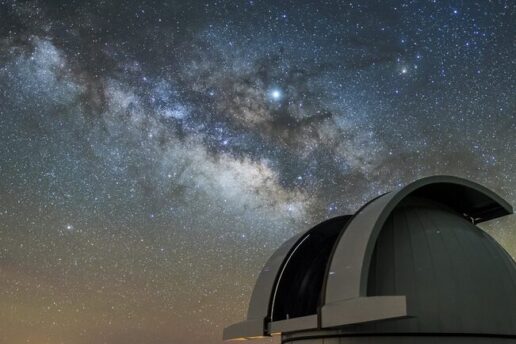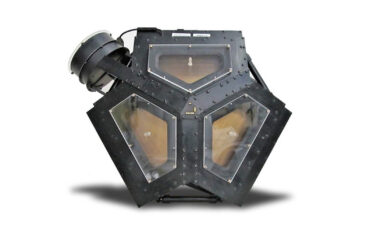
3Q: Julien de Wit PhD ’14 on searching for red worlds in the northern skies
MIT has completed the installation of its newest exoplanet-hunting telescope, Artemis, in the Canary Islands, joining the SPECULOOS network.
With a new telescope situated on a scenic plateau in Tenerife, Spain, MIT planetary scientists now have an added way to search for Earth-sized exoplanets. Artemis, the first ground-based telescope of the SPECULOOS Northern Observatory (SNO), joins a network of 1-meter-class robotic telescopes as part of the SPECULOOS project (Search for habitable Planets EClipsing ULtra-cOOl Stars), which is led by Michael Gillon at the University of Liège in Belgium and carried out in collaboration with MIT and several other institutions and financial supporters. Artemis is the latest product of a collaboration with MIT’s Department of Earth, Atmospheric and Planetary Sciences (EAPS). The other network telescopes that make up the SPECULOOS Southern Observatory — named Io, Europa, Ganymede, and Callisto after the four Galilean moons of Jupiter — are up and running at the Paranal Observatory in Chile, busily scanning the skies for exoplanets in the Southern Hemisphere.
Together, these SPECULOOS telescopes will look for terrestrial planets circling very faint, nearby stars, called ultra-cool dwarfs, and the new Artemis telescope will allow the research group to expand the search into the Northern Hemisphere skies. Artemis was unveiled today at an inauguration event attended by scientists and dignitaries from MIT, the University of Liège, and the Instituto de Astrofísica de Canarias (IAC) in Tenerife. Artemis was funded by MIT donors Peter A. Gilman, the Heising-Simons Foundation, and Colin and Leslie Masson, with additional support from the Ministry of Higher Education of the Federation Wallonie-Bruxelles, and the Balzan Foundation.
Before the SPECULOOS telescopes were conceived, researchers had already established the proof of concept for this technique with a project using a small, ground-based telescope located in La Silla, Chile, known as TRAPPIST (TRAnsiting Planets and PlanetesImals Small Telescope). With the TRAPPIST telescope, researchers looked at a limited sample of 50 target stars and discovered the TRAPPIST-1 system, which consists of seven terrestrial planets orbiting their cool, ultra-dwarf star. To date, these are the only known planets that are nearby, Earth-sized, temperate, and amenable for future atmospheric characterization, setting them apart from previous exoplanet findings. The SPECULOOS group is building on this earlier project with its new telescope network to scan more of the sky for similar Earth-sized exoplanets, and deliver more targets that can be assessed for habitability and potentially signs of life in the future.
Julien de Wit PhD ’14 is an EAPS assistant professor, SPECULOOS collaborator, Artemis principal investigator, and SNO co-principal investigator with Gillon. As a postdoc in the group of MIT Professor Sara Seager, he worked with Gillon and the TRAPPIST team to identify and characterize the TRAPPIST-1 system. Later he spearheaded the expansion of the SPECULOOS venture into the Northern Hemisphere. EAPS recently spoke with de Wit about the capabilities of Artemis and what we can expect to find with the SPECULOOS project.
Q: Tell us about the new Artemis telescope. Why is it particularly exciting?
A: The first telescope of the SPECULOOS Northern Observatory is named Artemis, built and owned by MIT, after the Greek goddess of the hunt, the wilderness, the moon, which seemed appropriate as we are hunting for planets and signs of life.
Artemis is located on the Spanish Canary Island of Tenerife about 150 miles off the coast of Morocco. The SNO is built within the Teide Observatory, which is an astronomical observatory by the Teide Volcano, 2,400 meters above sea level and operated by the Insituto de Astrofisica de Canarias. The location, which hosts one of the first major international observatories, boasts excellent astronomical conditions for viewing.
As far as the telescope itself, it measures about 4 meters high, with an optical quality of less than 0.8 arcsec and a field of view, 12 arcmin by 12 arcmin. Artemis, which was built by the German company ASTELCO, has a robot mount, and its detectors are very sensitive to the near-infrared wavelengths that we find emanating from these ultra-cool dwarf stars. We will be operating it remotely from MIT or any other collaborating institutes.
With TRAPPIST, we demonstrated a proof of concept — confirming that ultra-cool dwarf stars have the capacity to host planets — and are investigating the atmospheres of these TRAPPIST-1 planets with the Hubble Space Telescope. To date, there are no other temperate Earth-sized planets that would be such exquisite targets for atmospheric study. This justified fully scaling up with the SPECULOOS project.
Telescopes like this provide two important observational advantages. One, due to similar planet-to-star area ratios, the signal we’ll get from an Earth-sized planet transiting an ultra-cool dwarf star will be similar to a Jupiter-sized planet crossing in front of a sun-like star. Two, the vicinity of their habitable zone, due to their small size and temperature, means that habitable planets will have small transit periodicities, similar to gas giants, which are in close orbit around solar-type stars. This means that each star will require less monitoring time, and that the transit search targeting the roughly 1,200 nearest ultra-cool stars could be done in about 10 years with four telescopes scanning each hemisphere.
Q: What is the goal of Artemis, and how many exoplanets do you estimate can be evaluated by MIT’s new SPECULOOS Northern Observatory?
A: Over each night, we will be gathering pictures of a specific section of the sky, focused on our target stars in order to search for a brightness drop characteristic of a planetary transit.
The goal of the Artemis telescope is to look at the roughly 800 nearest ultra-cool dwarf stars located in the northern skies (and a sliver of the southern skies) to find Earth-sized planets that may have a temperate climate and be amenable for further in-depth characterization with the next generation of observatories, such as the James Webb Space Telescope (JWST) and the Extremely Large Telescopes. These will be able to tell us more about their atmosphere, climate, and what molecules might be present on them. We are confidently expecting to identify about 15 temperate planets with the SPECULOOS network, and doing so on a relevant timeline, which will allow for their atmospheres to be studied with the JWST, which is expected to launch in 2021 and last for 10 years.
Additionally, we’ll expand Artemis’s scope of work. We plan to do a follow-up of some of the trickiest planet candidates (terrestrial planets around small M-dwarfs) identified by the MIT-led TESS [Transiting Exoplanet Survey Satellite] NASA mission, since Artemis has 100 times larger viewing areas. We’ll also be able to study asteroids, comets, and other objects, such as observations of the Quaoar occultation, with other scientists at MIT and outside of the Institute.
Q: You mentioned that Artemis is the first telescope for the SPECULOOS Northern Observatory. Does that mean more telescopes might be added to the SPECULOOS network in the future?
A: Yes, we hope to build out the SPECULOOS Northern Observatory and add telescopes to accompany Artemis. As a matter of fact, we have already built an additional platform ready to host a twin to Artemis, as soon as we have found additional funding. Our agreement with the Teide Observatory reserves space to accommodate up to three additional telescopes. Doing so will allow us to thoroughly study all the nearest ultra-cool dwarf stars and complete the Northern Hemisphere survey in time to perform the atmospheric characterization of their transiting planets with the JWST.
With SPECULOOS, we are giving it our best shot at enabling the identification of habitats beyond Earth within the next decade. Our team is looking forward to sharing “first light” with our donors and the public, and it is a privilege for MIT to be working with our international partners on this exciting venture.


